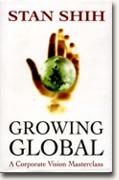Growing Global
Stan Shih
book reviews:
· general fiction
· chick lit/romance
· sci-fi/fantasy
· graphic novels
· nonfiction
· audio books
· author interviews
· children's books @
curledupkids.com
· DVD reviews @
curledupdvd.com
newsletter
win books
buy online
links
home
for authors
& publishers
for reviewers


|
Growing Global: Perspectives and Reflections of an Asian CEO Stan Shih Minn Song, Translator John Wiley & Sons Paperback 236 pages 2001  |
|
Growing Global is a rewritten series of lectures he gave at a Taiwanese university in 2000–01. In it he unveils his latest management wrinkle, “the Internet Organization" or IO. The IO is based on "virtual dream teams", which he envisions as small, ever-mutating groups of specialists who “task”—get together as a team, accomplish a project, and when finished, move on and reassemble for a new project. Mr. Shih claims that this "can turn Acer into a 'higher form' of organization." Well, maybe Acer under Mr. Shih, but most of the rest of Asia is led by of conservative, hierarchical, conformist, autocratic, men who also happen to be ill-interested in (a) the deluge-like advance of technological advancement, and (b) what their own young people are thinking of all this. Being in essence lectures to students, Mr. Shih’s book reads like rather well-penned, logical, but lusterless class notes. Sadly, in shaping his style for a student audience, one of the book’s shortcomings is vast over-simplification of complex realities without the statistical or anecdotal backup to clarify why the point can be so simplified. For example, take the statement, “Many Japanese companies take product quality to the point of perfection before releasing a product to the market; although they have mastered product quality, they have missed the timing, so the value they create is greatly compromised.” First of all, that isn’t true, as any Acura or Sony owner well knows. But more worrisome, isn’t this really saying, “Get to market and fix the problems later”? This and a few other comments like it remind one why the international image of Taiwanese products was for decades “quick’n’dirty”. On the brighter side, Mr. Shih definitely has a sharp mind when it comes to grasping the Big Picture. Extract his analyses of the differences between U.S., European, Japanese, Southeast Asian, and Taiwanese social and business cultures, and you would have the chapter outline for another book. His dissection of how those five cultures approach globalization is a thumb in the eye to anti-globalizers who monolithically interpret issues in terms of monolithic capitalism. The reality is that capitalism is about as monolithic as a playground. Mr. Shih elucidates the differences in corporate culture that enabled Dell, Compaq, Cisco Systems, IBM, Sony, and his own Acer to evolve distinctive conceptual differences about product creation and marketing. For example, the Microsoft and Cisco models are to buy up and integrate successful smaller companies into their own fold. Acer’s approach is rather like the incubator model in which a very slim-and-trim parent company spins off no end of tightly focused subsidiaries that get their job done and dissolve—again that IO structure he talks about. “Niche” is a word that crops up often in this book. It is a reality so much part-and-parcel the core of Asian life that it is amazing more American companies don’t “get it”. They tend to go into a country with—pardon the term—both guns blazing, lavishly spending on large-scale ad campaigns, creating massive distribution and retailing networks, and in general interpreting Asia as little more than another mass-market. Problem is, Asia is 300 million people occupying 3,000 cultural niches. Can one really apply marketing ideas to the inhabits of a valley in Northern Thailand the same way as to a hip young kid in Bangkok? Can one lump together the wealthy socialites of any given city with its recent-graduate first-jobbers, both of whom shop the same cosmetics counters in the same mall gallerias but buy very different product lines to convey very different social images? Most Westerners don’t live in Asia on the street level. Hence they don’t develop a sensitivity for how the place works. Asia isn’t a series of markets, it is a vast number of cultural courtyards. A courtyard is a traditional-laden common meeting ground—of things or ideas, take your pick—in which one side is bounded by the public market, another by the religious temple or mosque, a third by the political infrastructure, and the last by customs and taboos that govern the first three and have been doing it from before words were written. Mr. Shih addresses the issue of Asian nichification constantly throughout the book—although not expressed in the metaphor above. His terminology is traditional—globalization, functionality, value creation, corporate strategy, reengineering. You can just imagine the dutiful students scribbling their ballpoints dry. Which brings up a painful observation. Nearly all the text is bounded by buzzwords popular about five years ago. The effect is rather like reading the complete technical specifications of a Ferrari that won the ‘52 Le Mans Grand Prix. There is no mention of social and political dynamics that drive the computer and internet development in India. Not a word about the successful data entry and overnight software models that originated in Bangalore and created a huge market for Indian talent in the United States. Linux and open-sourcing get so little attention they seem to barely exist (and worse, aren’t even in the index). There is a reason for this. Mr. Shih is an old-line industrialist, even though his product vision in this book happens to be internetware. His preoccupation with quality manufacturing and point of value-addition overlook enormous social changes burbling away beneath Asia’s corporate-speak. There is no mention, perhaps not even a recognition, of the major generational gaps which divide Asia today which will turn into chasms over the next 25 years. Mr. Shih is of the “Grand Generation” of major corporate and political leaders who shaped the region from fifty to twenty years ago. This generation carved out the great trade and industrial empires and set into motion the political attitudes that dominate the region today. This Old Guard is now in its 70s and 80s. Although the 25 years of a generation separates the Old Guard from their sons—today’s middle managers now coming into directorships, only one thing tends to separate them in their value systems: today’s 40s to 60s were largely educated overseas and look to the West for models and inspiration (indeed, as does Mr. Shih throughout the book). But the students Mr. Shih was addressing at Chiaotung University were raised in a radically different atmosphere: the internet, the computer at home, and now the group games. To walk into a Singapore or Bangkok cybercafe that caters to the tweeny generation is an unnerving experience. The roar when you open the door is reminiscent of the scene in Tom Wolfe’s “Bonfire of the Vanities” in which someone opens the door of the N.Y. Stock Exchange trading floor and is hit by a great roaring wall of sound that sounds like, well, the Masters of the Universe at work. That’s what it is like to be around Asia’s tweenies and early thirtysomethings (all males, by the way). In their conversation, in their group gaming, in their a-political and a-corporate views of their future, they are not really rebellious, but they are of such a different mindset that the ideas of Mr. Shih must come across to them as precambrian. The younger generation has their elders figured out with a clarity that would induce apoplexy in the older generation if only they knew of it. But they don’t know. Older Asia hasn’t a clue what younger Asia is thinking. That is what is so disturbing about thinking—no matter how well-intended—like this from Mr. Shih: “In Asia, business diversity in the past was achieved through protectionism, the dominance of financial conglomerates, and collusion between government and business; in the diverse business environment of the new, freer economy, the question is: can you stay focused competitively? If you don’t excel at what you do, how can you compete?”True enough, but there is not a single new idea in this paragraph, and unfortunately, not many more in the rest of the book. Tellingly, there are only two bibliographical references in lieu of a bibliography. One of them is his own 1996 book Me Too Is Not My Style and the other is Tom Peters’ and Robert Waterman’s 1988 largely discredited In Search of Excellence. © 2002 by Dana De Zoysa for Curled Up With a Good Book |
|
|
|
 Click here to learn more about this month's sponsor! |
|
| fiction · sf/f · comic books · nonfiction · audio newsletter · free book contest · buy books online review index · links · · authors & publishers reviewers |
|
| site by ELBO Computing Resources, Inc. | |
 Unlike the Standard Industrial Model of the Corporate Reflections book, this
book is really a ghost-written puff piece for the CEO. He has much praise for
his company and its employees, but there is not a single instance in the
entire book where he has patted himself on the back for Acer’s success. So
there, Mr. Welch.
Unlike the Standard Industrial Model of the Corporate Reflections book, this
book is really a ghost-written puff piece for the CEO. He has much praise for
his company and its employees, but there is not a single instance in the
entire book where he has patted himself on the back for Acer’s success. So
there, Mr. Welch.